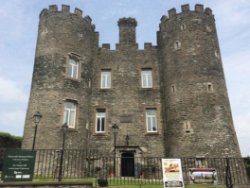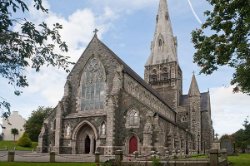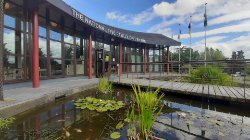Memory Lane: Enniscorthy
For this instalment of the Memory Lanes Series, we are once again hopping on a train on the Rosslare Europort line, but this time to the picturesque town of Enniscorthy.
As with most towns and now cities throughout Ireland, this large urban area owes its inception to a river – in this case, The Slaney. When most people hear the name Enniscorthy, they immediately think of the key role it played in the 1798 Rebellion – a key event mentioned in history textbooks used in schools throughout Ireland.
As with most towns and now cities throughout Ireland, this large urban area owes its inception to a river – in this case, The Slaney. When most people hear the name Enniscorthy, they immediately think of the key role it played in the 1798 Rebellion – a key event mentioned in history textbooks used in schools throughout Ireland.
.jpg?width=500&height=333)
Enniscorthy Castle
 As you walk down the hill from the train station and stand on the 400-year-old Enniscorthy Bridge, at eye level you can see the pretty fronts of shops and other businesses, with many vibrant flower displays hanging from the windowsills. Your eye will also be drawn to the impressive and imposing castle on the hill. As your gaze drifts to the right, you will also see the spire of the beautiful St. Aidan’s Cathedral.
As you walk down the hill from the train station and stand on the 400-year-old Enniscorthy Bridge, at eye level you can see the pretty fronts of shops and other businesses, with many vibrant flower displays hanging from the windowsills. Your eye will also be drawn to the impressive and imposing castle on the hill. As your gaze drifts to the right, you will also see the spire of the beautiful St. Aidan’s Cathedral. Just a few yards away, one might occupy one of the umbrella festooned tables and enjoy a sausage sandwich and cup of tea from Impressions café across the road. En route to visiting the castle, many a tourist has stepped inside the quaint ‘Antique Tavern’ to quench their thirst before heading further up Slaney Street.
As with many towns on the East Coast of Ireland, it was the arrival of The Norman’s (at the invitation of Diarmaid mac Murchadha) that led to the first outline of a proper settlement being created. The first references to the castle dates back to 1190, to a Philip de Prendergast, who married a Maud de Quency, a granddaughter of the infamous Strongbow. The castle then changed hands among different owners, including Art McMurrough, a descendant of the famous Diarmaid and the Earl of Portsmouth who in 1898, leased the castle to one Henry J. Walsh, who had a numbers of businesses in the town. The castle was used as a barracks by the Free State Army during the Irish Civil War.
It was later bought by the Roche Family, who would reside there until 1922, when the increasing and crippling cost of maintaining such a dwelling became too much. The castle laid derelict until 1951, when it reopened as a museum that became accessible to the public at large. If you'd like to visit Enniscorthy Castle on your next trip, download GeoFindIT here to find the all the tourist attractions and heritage sites nearby.
St. Aidan’s Cathedral
 If you continue down main street, you will soon arrive at Saint Aidan’s Cathedral. First opened in 1843, this church was designed by Augustus Welby Pugin, reputedly based on the famous Tintern Abbey in Chepstow, Wales.
If you continue down main street, you will soon arrive at Saint Aidan’s Cathedral. First opened in 1843, this church was designed by Augustus Welby Pugin, reputedly based on the famous Tintern Abbey in Chepstow, Wales.Inside the cathedral, one will find beautiful arch like columns stretching down the aisles and a number of beautifully decorated stained glass windows, which are quite the sight to behold when the sun shines in. St. Aidan's Cathedral can be found amongst many more heritage sites around Enniscorthy on our free location app GeoFindIT.
National 1798
 After taking a short 10-minute stroll down Parnell Street, you come across another main tourist attraction in town – The National 1798 Rebellion Centre. This museum commemorates the famous rebellion of 1798 when a combined army of Wexford peasants and local aristocrats rose up against British rule in Ireland. The rebellion was technically an island-wide event, but in reality, apart from a section of Ulster and Wexford; it was a flop.
After taking a short 10-minute stroll down Parnell Street, you come across another main tourist attraction in town – The National 1798 Rebellion Centre. This museum commemorates the famous rebellion of 1798 when a combined army of Wexford peasants and local aristocrats rose up against British rule in Ireland. The rebellion was technically an island-wide event, but in reality, apart from a section of Ulster and Wexford; it was a flop.After defeating the British Yeomanry (part-time reservist) forces at Oulart Hill, the ‘Pikemen’ as they have become known, marched the around 14km to Enniscorthy where they captured the town before taking over the rest of county Wexford and parts of Carlow and Wicklow. There was a widespread rumour that a supporting French army would be soon be with them, but bad weather meant this did not come to pass.
After a brave stand, the rebels were routed by the much better trained and equipped army led by General Gerard Lake at Vinegar Hill, in Enniscorthy. This effectively ended the rebellion in Wexford, where the flicker of the flame of Irish freedom had lasted for almost 6 months and would inspire more rebels in 1916.
There was a large contingent of Irish Republican Brotherhood members in Enniscorthy, one of the key pillars of the 1916 rising. Outside Enniscorthy, there was little or no republican activity in the South East of the country, so the hoped for insurrection failed to get off the ground in that part of Ireland.
Art and Design
As you walk around Enniscorthy Castle, you will be greeted by the sight of splendid furnishings on Level 2. These are the work of the world renowned Enniscorthy born designer, Eileen Gray. Regarded as one of the foremost exponents of the ‘Lacquer’ art technique, they also branched out into furniture design, which included her famous ‘Bibendum’ chair (whose inspiration came from the Michelin Man figure). She then went onto design the highly praised Villa named “E1207” – A cryptic nod to her lovers at the time – which was built in a stunning seafront located in the area of Cap Moderne, around 6km to the east of Monaco.
So why not plan your next staycation to Enniscorthy and experience it's historical legacy first hand? If you're looking for directions or need help finding the best places to eat or sites to see, use our free location app GeoFindIT to help take the stress out of planning your trip.
If you liked this blog, you may be interested in our Memory Lanes trip to Newbridge.
Image sources:
Enniscorthy
Enniscorthy Castle
1978 National Rebellion Centre
St. Aidans Cathedral
Posted: 07/10/2021 11:50:17